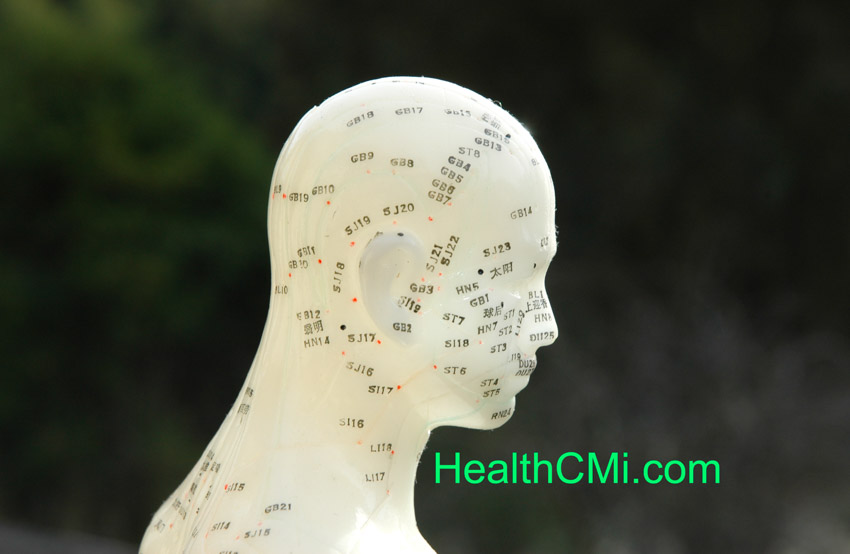
Acupuncture improves stroke patient outcomes. Suining County People’s Hospital researchers determined that acupuncture combined with thrombolytic therapy is more effective than thrombolytic monotherapy for acute cerebral infarction patients. [1] This type of stroke is often referred to as an ischemic stroke. It is due to blood vessel disorders that result in disruption of brain blood flow and result in deprivation of oxygen and nutrients.
The Suining County People’s Hospital human clinical trial is supported by a recent laboratory discovery. In an independent investigation, researchers successfully quantified therapeutic biochemical changes induced by acupuncture. The acupuncture plus thrombolytic therapy test group outperformed the thrombolytic therapy monotherapy group. The group that had acupuncture treatments had better protein and mRNA expressions of VEGF and bFGF, lower neurological deficit scores and percentage of cerebral infarction volume, and improved regulation of protein and mRNA expressions of endostatin (ES). [2]
The Suining County People’s Hospital clinical trial involved combining acupuncture with urokinase therapy. Urokinase occurs naturally in the human body but is also manufactured for the purposes of breaking-up blood clots. Patients receiving both urokinase and acupuncture in a combined treatment protocol had superior patient outcomes compared with patients receiving only urokinase. The researchers conclude that the addition of acupuncture increases the thrombolytic effect of urokinase for the treatment of acute cerebral infarction.
A total of 60 patients were treated and evaluated in this study. They were randomly divided into an acupuncture treatment group and a control group, with 30 patients in each group. For the control group patients, urokinase was injected through the intravenous (IV) route after onset of an acute cerebral infarction. The treatment group received acupuncture in addition to the identical thrombolytic therapy administered to the drug control group.
The statistical breakdown for each randomized group was as follows. The treatment group consisted of 12 males and 18 females. The average age in the treatment group was 52 years. The average course of disease in the treatment group was 10 months. The control group consisted of 13 males and 17 females. The average age in the control group was 55 years. The average course of disease in the treatment group was 8 months. There were no significant statistical differences for patients initially admitted to the study.
The treatment group patients received acupuncture therapy using mainly the Xing Nao Kai Qiao (regaining consciousness and opening the orifices) acupuncture prescription. The acupoints included the following:
- GV26 (Shuigou)
- GV20 (Baihui)
- HT1 (Jiquan)
- LI15 (Jianyu)
- LI11 (Quchi)
- LI4 (Hegu)
- ST36 (Zusanli)
- ST40 (Fenglong)
Additional acupoints were added for specific symptoms. For facial paralysis, the following acupuncture points were added:
- ST4 (Dicang)
- ST6 (Jiache)
For speech impairment, the following acupuncture point was added:
- CV23 (Lianquan)
Multiple instruments were used to measure patient outcomes at several data points: prior to treatment (T1) and 24 hours (T2), 21 days (T3), 3 months (T4), and 6 months (T5) after completion of treatment. First, the NIH Stroke Scale (NIHSS) score was calculated. The NIHSS is an examination tool used to assess cognitive effects due to acute cerebral infarction. Second, improvement of patients’ consciousness level was measured using the Glasgow Coma Scale (GCS). Third, patients’ ability in performing activities of daily living was recorded using the Activities of Daily Living (ADL) scale. The results of NIHSS, GCS, and ADL assessments indicate that acupuncture combined with urokinase into an integrated treatment protocol is more effective than urokinase as a standalone therapy. [3]
The clinical trial is supported by a recent laboratory investigation wherein Lu et al. identified biochemical responses elicited by acupuncture responsible for enhancing the therapeutic benefits of thrombolytic therapy. [4] The study quantified acupuncture’s effects on vascular endothelial growth factor (VEGF), basic fibroblast growth factor (bFGF), and endostatin (ES). VEGF is an angiogenic factor that promotes endothelial cell proliferation, differentiation, and migration. Basic fibroblast growth factor (bFGF) is a signaling protein involved in biological processes such as cell growth and tissue repair. ES is an important vasculogenic inhibitor that acts by antagonizing VEGF.
In the laboratory investigation, four groups of rats with cerebral infarctions were compared: the model group, the sham model group, the drug monotherapy group, and the drug plus acupuncture group. For the drug only group, thrombolytic therapy was given 6 hours after modeling using recombinant tissue plasminogen activator (rtPA). During the treatment, rtPA was diluted to 1 mg/mL with sterile water and injected slowly at 10 mg/kg through a vein.
For the acupuncture plus drug group, acupuncture intervention was given 2 hours after modeling and the thrombolytic therapy was given 6 hours after modeling using the identical medication given to the drug monotherapy group. During the acupuncture treatment, Shuigou and Neiguan on both sides were selected based on the Animal Acupoint Positioning Graph developed by the Experimental Acupuncture Research Institute of the Chinese Acupuncture and Moxibustion Society. The attenuating (Xie) technique was used. The needles were retained for 30 minutes. The model group and the sham model groups did not receive acupuncture treatment.
Compared with the other groups, the drug plus acupuncture group had significantly higher protein and mRNA expressions of VEGF and bFGF and significantly lower neurological deficit scores, percentage of cerebral infarction (CI) volume, and protein and mRNA expressions of ES. The researchers conclude that acupuncture improves thrombolytic therapy results by upregulating protein and mRNA expressions of VEGF and bFGF and by downregulating ES.
References:
[1] Li, Yang. (2011). The Influence of Acupuncture on the Thrombolytic Effect after Acute Ischemic Cerebral Infarction. Shanghai Journal of Acupuncture and Moxibustion, 30(009), 591-593.
[2] Chang Siqi, et al. (2021). Acupuncture intervention prolongates thrombolysis time window by regulating cerebral cortex angiogenesis-related genes and proteins in cerebral infarction rats. Acupuncture Research, 46(09), 751-756.
[3] Li, Yang. (2011).
[4] Chang Siqi, et al. (2021).


